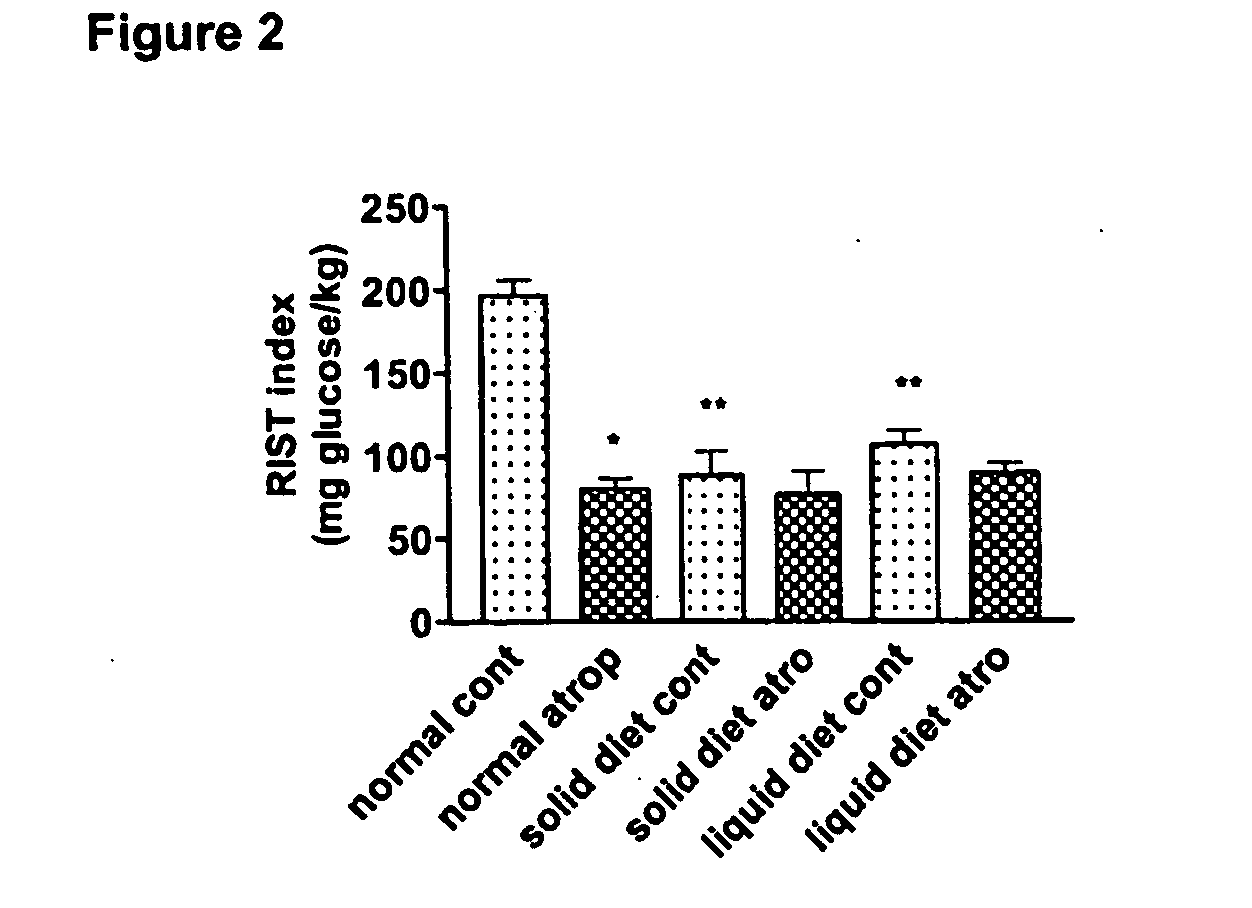Use of cholinesterase antagonists to treat insulin resistance
a technology of cholinesterase and antagonists, which is applied in the field of insulin resistance treatment, can solve the problems of incomplete exhaustion of the pancreas and insufficient hepatic glycogen storage capacity to handle all of the glucos
- Summary
- Abstract
- Description
- Claims
- Application Information
AI Technical Summary
Benefits of technology
Problems solved by technology
Method used
Image
Examples
example 1
Animal Studies
Male Sprague Dawley rats (250-300 g) were allowed free access to water and normal rodent food for 1 week prior to all studies. Rats were fasted for 8 hours overnight and fed for 2 hours before the start of study.
Rats were anesthetized with pentobarbital-sodium (65 mg / ml, ip injection, 0.1 ml / 100 g body weight). Animals were placed on a heated thermostatically controlled surgical table to maintain body temperature during surgery and the experimental procedure.
An extracorporeal arterial-venous shunt (the loop) was established between the right femoral artery and right femoral vein, according to a published, standard operating procedure developed in our laboratory (Xie et al., 1996). The loop allows for regular blood sampling of arterial blood throughout the experiment as well as infusion of intravenous drugs and monitoring of arterial blood pressure.
A tracheal breathing tube was inserted to ensure a patent airway and the jugular vein was ca...
example 2
Development of HDIR in a Model of Insulin Resistance Produced by High Sucrose Diets in Rats
It has been well documented that feeding rats a diet high in sucrose leads to a state of insulin resistance. The insulin resistance produced by this model has recently been shown to be HDIR.
Sucrose-fed Model of Insulin Resistance
Two approaches to sucrose-feeding were used in this investigation. In group one, 3 week old (weanlings), male, Sprague Dawley rats, were supplied for 12 weeks with a solid pellet diet in which 35% of all calories came from sucrose (solid diet group, Research Diets Inc.). In a second group, male, Sprague Dawley rats, approximately 6 weeks of age were provided free access to a 35% w / vol sucrose and water solution in addition to regular rodent pellet diet and normal drinking water for a 9 week period (liquid diet group).
Series 1: Assessment of HDIR in Sucrose Fed Rats
After the noted feeding period, both groups of rats were tested to determine the degree of HDIR...
example 3
Reversal of HISS-dependent Insulin Resistance in Sucrose-fed Rats using Anticholinesterase Agents
Since both forms of diet produced the same degree of HDIR, the model of sucrose feeding using the liquid diet was used to determine whether this HDIR was reversible with the anticholinesterase agent, neostigmine.
The model of insulin resistance produced by the 35% liquid sucrose diet (in addition to regular rodent food pellets and normal drinking water) was identical to the protocol described above for the assessment of HDIR in sucrose-fed rats.
Rats were fasted for 8 hours overnight and fed for 2 hours before the start of study. The surgical preparation was identical to that described above for sucrose-fed rats tested for HDIR. In addition, a laparotomy and portal vein cannulation were carried out. In brief, an arterial-venous shunt / loop was established, a tracheal breathing tube inserted and the jugular vein was cannulated. Following a laporotomy, the portal vein was cannulated.
...
PUM
| Property | Measurement | Unit |
|---|---|---|
| insulin resistance | aaaaa | aaaaa |
| resistance | aaaaa | aaaaa |
| degree of reduction | aaaaa | aaaaa |
Abstract
Description
Claims
Application Information
 Login to View More
Login to View More - R&D
- Intellectual Property
- Life Sciences
- Materials
- Tech Scout
- Unparalleled Data Quality
- Higher Quality Content
- 60% Fewer Hallucinations
Browse by: Latest US Patents, China's latest patents, Technical Efficacy Thesaurus, Application Domain, Technology Topic, Popular Technical Reports.
© 2025 PatSnap. All rights reserved.Legal|Privacy policy|Modern Slavery Act Transparency Statement|Sitemap|About US| Contact US: help@patsnap.com



